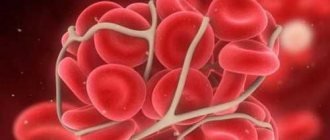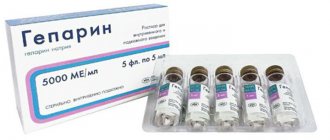Arterial hypertension (AH) is one of the most pressing health problems both in Russia and throughout the world. This is due to the high prevalence and high risk of its complications - coronary heart disease (CHD), cerebral strokes, heart and kidney failure. The prevalence of hypertension in economically developed countries reaches 25% [1].
In Russia, 40% of men and women over 18 years of age have elevated blood pressure (BP) [2]. According to Russian recommendations for the diagnosis and treatment of hypertension, the strategic goal of therapy for this disease is to reduce the risk of cardiovascular complications (CVC) as much as possible. The most important condition for effective antihypertensive therapy is adequate blood pressure control, i.e. achieving its target level, which is taken as blood pressure
However, in Russia, only 5.7% of men and 17.5% of women with hypertension achieve target blood pressure levels. If you do not increase the effectiveness of therapy, i.e., do not increase the proportion of adequately treated patients with hypertension, you cannot count on a turning point in reducing cardiovascular risk.
Currently, it is possible to use two strategies for treating hypertension to achieve target blood pressure: monotherapy and combination treatment (see figure). Monotherapy is based on finding the optimal drug for a particular patient, and switching to combination therapy is advisable only if the latter has no effect. Combination therapy already at the start of treatment involves the selection of an effective combination of drugs with different mechanisms of action.
Each of these approaches has its own advantages and disadvantages. The advantage of monotherapy is that if the drug is successfully selected, the patient will not need to additionally take another drug. However, as a rule, with monotherapy it is possible to achieve target blood pressure on average only in 30–40% of patients with hypertension. This is quite natural, since one class of drugs is not able to control all pathogenetic mechanisms of increased blood pressure: the activity of the sympathetic nervous system and the renin-angiotensin-aldosterone system, volume-dependent mechanisms. In addition, monotherapy requires the doctor to painstakingly search for the most optimal antihypertensive drug for the patient with frequent changes in drugs and their dosages, which often deprives the doctor and the patient of confidence in success and ultimately reduces adherence to treatment. This is especially true for patients with mild and moderate hypertension, most of whom do not experience discomfort from increased blood pressure and are not motivated to treatment.
The disadvantage of combination therapy is the inconvenience associated with the fact that the patient has to additionally take one more, and sometimes several, drugs. However, in most cases, the prescription of antihypertensive drugs with different mechanisms of action allows, on the one hand, to achieve target blood pressure, and on the other hand, to minimize the number of side effects. Combination therapy also makes it possible to suppress counterregulatory mechanisms of increased blood pressure. Thus, the transition to combination therapy, which allows effective control of various mechanisms of increased blood pressure, gives hope for increasing the effectiveness of antihypertensive therapy.
There are various combinations of antihypertensive drugs. Among the combinations of two drugs, the following are considered effective and safe: diuretic + beta-blocker; diuretic + ACE inhibitor (ACE inhibitor); diuretic + angiotensin II receptor antagonist (ARA); dihydropyridine calcium antagonist + beta-blocker; calcium antagonist + ACE inhibitor; calcium antagonist + diuretic; alpha-blocker + beta-blocker; centrally acting drug + diuretic. In addition, combinations of an ACE inhibitor, a calcium antagonist, an ARA and a diuretic with an I1 imidazoline receptor agonist are possible. The most popular in Russia is the combination of an ACE inhibitor and a diuretic. As the results of the Pythagoras study show, almost a third of doctors in Russia prefer a combination of these drugs [4].
The most important step towards improving the strategy of combination therapy was the creation of fixed combinations of antihypertensive drugs (two components in one tablet), which significantly improve patient adherence to therapy. However, along with the advantages (the ability to take one tablet containing two drugs), this approach also has serious disadvantages. Thus, the doctor cannot vary the doses of each of the drugs included in the combination, which complicates treatment, especially when adverse reactions occur that are clearly related to one of the components included in the combination. To avoid such difficulties, it was necessary to create several different dosage forms, which may partially alleviate the problem (for example, the drugs Enap-H and Enap-HL, containing different doses of the diuretic), but does not solve it completely.
In this regard, it is of interest to create non-fixed combinations containing two drugs in one blister, which will allow, if necessary, to vary the doses of each of them. The first drug of this type in Russia was Enzix - a combination of enalapril with indapamide.
The creation of this form of the drug was largely facilitated by the results of the multicenter study EPIGRAF, in which doctors from 38 clinics from 17 cities of Russia took part [5]. In total, the study included 550 patients with grades II–III hypertension (initial systolic blood pressure > 160 mm Hg), and among them there were patients not only with essential, but also with symptomatic hypertension. A feature of this study was that already at the beginning of treatment, patients were prescribed a combination of enalapril and indapamide. Moreover, if the dose of indapamide was constant - 2.5 mg, then the dose of enalapril varied depending on the initial blood pressure level. However, doctors had the opportunity to adjust doses depending on the achievement of the target blood pressure level within 14 weeks. The average dose of enalapril in the study was 15.2 mg. As a result of treating patients with hypertension with differentiated doses of enalapril and indapamide, it was possible to achieve a significant reduction in both systolic and diastolic blood pressure. Moreover, in 70% of patients it was possible to achieve the target blood pressure level, despite its very high initial level. Adverse reactions were noted in only 8.1% of patients, and in 5.4% they were due to an excessive decrease in blood pressure, which can be eliminated with more careful selection of drug dosages.
The main conclusion of the study is that the effectiveness and safety of the combination of enalapril with indapamide in the treatment of hypertension does not depend on gender, age and the cause of the increase in blood pressure (primary hypertension or secondary hypertension of renal origin). Particular attention should be paid to the latter circumstance in connection with the entrenched opinion that the effectiveness of antihypertensive therapy is lower in patients with symptomatic hypertension. The combination of enalapril with indapamide was especially preferred in women in whom ACE inhibitor monotherapy may be less effective.
The results of the EPIGRAF study made it possible to work out the most effective doses of enalapril and indapamide for patients with hypertension of varying degrees, which became the basis for the creation of three types of the drug Enzix: ENZIX - 10 mg of enalapril and 2.5 mg of indapamide (single dose in the morning) for patients with stage I hypertension; ENZIX DUO – 10 mg enalapril and 2.5 mg indapamide (morning) + 10 mg enalapril (evening) for patients with stage II hypertension; ENZIX DUO FORTE – 20 mg enalapril and 2.5 mg indapamide (morning) + 20 mg enalapril (evening).
The effectiveness and safety of Enzix were assessed in the EPIGRAPH-2 study, which was a comparative randomized multicenter study that included nine centers in Russia and one in Serbia [6]. A total of 313 patients were included in the study and randomized into two groups. The Enzix group included 211 patients, and the control group included 102 patients. The control group was treated with other classes of antihypertensive drugs (except ACE inhibitors and diuretics). After 2, 4 and 6 weeks of treatment in cases where it was not possible to achieve target blood pressure (
All patients randomized to the Enzix group were divided into two subgroups depending on the initial blood pressure level.
In the first subgroup, 118 patients with stage I hypertension and initial systolic blood pressure of 140–160 mm Hg. Art. a combination of 10 mg enalapril and 2.5 mg indapamide (corresponding to the ENZIX form) was prescribed. During treatment, 88 (74.6%) of them continued to take the original dose, and in 26 (22.1%) patients the dose of enalapril was doubled (10 mg in the morning + 10 mg in the evening) while maintaining the dose of indapamide (2.5 mg in the morning ), which corresponded to the ENZIX DUO form. Only one patient with stage I hypertension required a combination of 40 mg of enalapril (20 mg in the morning + 20 mg in the evening) and 2.5 mg of indapamide, which corresponded to the ENZIX DUO FORTE form. Three patients did not complete the study.
In the second subgroup, 93 patients with stage II hypertension and systolic blood pressure 160–180 mm Hg. Art. Therapy began with 20 mg of enalapril (10 mg each morning and evening) and 2.5 mg of indapamide (corresponding to the ENZIX DUO form). During treatment in 46 patients, this dosage was maintained, and in 45 patients, the dose of enalapril was increased to 40 mg/day (20 mg in the morning + 20 mg in the evening) with a constant dose of indapamide 2.5 mg, which corresponded to the form of ENZIX DUO FORTE. For two more patients, the initial dose of enalapril was reduced to 10 mg while maintaining the original dose of 2.5 mg of indapamide, which corresponded to the ENZICS form.
When analyzing the number of patients whose blood pressure levels normalized as a result of treatment, the group of patients receiving Enzix (72.5%) had some advantages compared to the control group (66.7%). And this, despite the fact that systolic blood pressure in the “experimental” group was initially 2.7 mm Hg. Art. higher than in the control. If we sum up the total number of patients who responded positively to treatment (the number of patients with normalization of blood pressure or a decrease in systolic blood pressure by more than 20 mm Hg from the initial level), then by the end of treatment it reached 82.4% on average for the group, taking Enzix, and among patients with stage I hypertension this value was 89.8%, and in patients with stage II hypertension – 77.2%.
Thus, early treatment of patients with grades I–II hypertension with a non-fixed combination of enalapril and indapamide (Enzix) in comparison with routine antihypertensive therapy makes it possible to achieve normalization of blood pressure levels more often. In addition, the Enzix group was able to significantly reduce the number of patients with left ventricular hypertrophy and proteinuria, improve quality of life, and reduce the number of hospitalizations and additional visits to the doctor. Among other things, Enzix therapy is cost-effective.
Very important importance is currently attached to the metabolic effects of antihypertensive therapy. The essence of the metabolic theory is that a number of antihypertensive drugs, such as diuretics and beta-blockers (especially non-selective ones), tend to worsen the lipid profile and worsen insulin resistance, which can in the long term increase the risk of developing diabetes mellitus and reduce the effectiveness of therapy in preventing the development of cardiovascular disease [7].
Recently completed large-scale studies have confirmed the validity of the metabolic theory. In groups of patients taking diuretics and beta-blockers, the incidence of diabetes was significantly higher than when treated with calcium antagonists, ACE inhibitors and ARBs [8–10]. In this regard, the effectiveness of antihypertensive therapy must be assessed not only from the point of view of achieving target blood pressure, but also from the standpoint of the likelihood of metabolic effects. This fully applies to combination therapy. It is appropriate to emphasize that the components of Enzix do not cause concern in this regard. Enalapril, as studies show, is metabolically neutral, and indapamide occupies a special place among diuretics. At recommended doses (1.5–2.5 mg per day), it not only provides adequate antihypertensive effects, but is also metabolically neutral. It has been proven that indapamide does not cause hypokalemia or changes in carbohydrate [11] and lipid profiles [12]. Particularly compelling evidence for the metabolic indifference of indapamide comes from a meta-analysis of three studies involving a total of 1195 patients. Based on the results of treatment with the retard form of indapamide for 9–12 months, no effect on carbohydrate and lipid profiles, as well as uric acid levels, was detected [13].
In addition to the diuretic effect, indapamide has a vasodilating effect by reducing the sodium content in the arterial wall, regulating the entry of calcium into vascular smooth muscle cells, as well as increasing the synthesis of prostaglandin E2 in the kidneys and prostacyclin in the endothelium [14]. Thus, indapamide, having a more pronounced direct effect on blood vessels compared to other diuretics, affects endothelial function. It has an antioxidant effect, increasing the bioavailability of NO and reducing its destruction [15]. The LIVE study demonstrated the ability of indapamide therapy to cause regression of left ventricular myocardial hypertrophy [16].
Combined antihypertensive therapy: current status
Hypertension is a hemodynamic disorder by definition, and increased peripheral vascular resistance is a distinctive hemodynamic feature of elevated blood pressure. Understanding of this fact led to the discovery and development of a special class of vasodilators with a targeted mechanism of action, although many of the previously used antihypertensive drugs also had a vasodilating effect, for example, by blocking the activity of the sympathetic nervous system. The first nonspecific vasodilator was hydralazine, followed by vasodilators blocking calcium channels of vascular smooth muscle cells (calcium antagonists - AK), postsynaptic α-adrenergic receptors of peripheral neurons of the sympathetic nervous system (α-blockers) and blockers of the renin-angiotensin-aldosterone system (RAAS) ( angiotensin-converting enzyme inhibitors (ACEIs), angiotensin receptor blockers (ARBs); finally, the latest to appear are direct renin inhibitors (DRIs). The vasodilating effect is also inherent in thiazide diuretics (TD), which, by reducing the sodium content in vascular smooth muscle cells, reduce their sensitivity to vasopressors - catecholamines, etc. When using antihypertensive drugs in a heterogeneous population of patients with hypertension, the selectivity of the active substances and their other features lead to an unpredictable decrease in blood pressure in each individual patient. For example, prescribing an ACE inhibitor to a patient with hyperactivation of the RAAS due to renal artery stenosis will lead to a significant decrease in blood pressure and renal dysfunction [2]. In turn, the prescription of ACE inhibitors to elderly people and people of the black race (who in most cases have a reduced level of RAAS activity) will lead to only a slight decrease in blood pressure [3]. Most often, the “phenotype” of hypertension in a particular patient remains unspecified. A recent meta-analysis of 354 placebo-controlled studies of different antihypertensive monotherapy regimens in unselected hypertensive patients (n=56,000) showed a mean (placebo-adjusted) reduction in systolic blood pressure of 9.1 mm Hg. and diastolic blood pressure – by 5.5 mm Hg. [4]. These average values hide a wide range of individual responses to antihypertensive therapy - from a decrease in SBP by 20–30 mmHg. and until there is a complete lack of effect, and sometimes even a slight increase in blood pressure [5]. The second factor that determines the individual response to antihypertensive monotherapy is individual differences in blood pressure counter-regulation systems activated in response to a decrease in its level. In some cases, such a reaction can completely compensate for the decrease in blood pressure. Thus, the use of antihypertensive monotherapy does not always give a satisfactory result. What should be the next step in a situation like this? Should the dose be increased, the drug changed, or a combination of antihypertensive agents used? Rationale for the use of combination antihypertensive therapy The rationale for the use of combination therapy for hypertension is quite obvious. Firstly, in contrast to blindly prescribed monotherapy, a combination of drugs acting on different blood pressure regulation systems significantly increases the likelihood of its effective reduction. Secondly, prescribing a combination of drugs can be regarded as an attempt to block the activation of counter-regulatory systems that counteract the decrease in blood pressure during the use of monotherapy (Fig. 1). Thirdly, a significant part of the population of patients with hypertension suffers from so-called moderate or severe hypertension (stage 2) [6], this group includes patients with systolic blood pressure more than 160 mm Hg. and/or diastolic blood pressure more than 100 mm Hg, which is about 15–20% of all patients with hypertension. These patients are at the highest risk of cardiovascular events. Increase in blood pressure for every 20 mm Hg. doubles the risk of such events. The risk of hypertension increases with age, and the proportion of patients with stage 2 hypertension also increases. Age is also associated with an increase in the proportion of patients with isolated systolic hypertension, which causes loss of vascular elasticity and an increase in vascular resistance. Despite some differences in recommendations, in some of them combination treatment is considered first-line therapy, although only under certain conditions. Such a place for combination therapy is logical due to the risks of severe hypertension, recognition of the inevitability of using double (and sometimes triple) therapy to achieve target blood pressure values less than 140/90 mm Hg. and the need to quickly reduce blood pressure to a more acceptable level to reduce existing risks. For systolic blood pressure 20 mmHg above target and/or diastolic blood pressure 10 mmHg above target, the US Joint National Committee on the Prevention, Diagnosis and Treatment of High Blood Pressure (JNC–7) recommends start antihypertensive therapy with a combination of two drugs. Similar recommendations are contained in the latest Russian guidelines, and the recommendation for the use of first-line combination antihypertensive therapy also applies to patients with lower blood pressure levels who have multiple risk factors, target organ damage, diabetes mellitus, kidney disease or associated cardiovascular diseases [ 7]. There are concerns that the use of more than one antihypertensive drug at the beginning of treatment may in some cases provoke clinically significant hypotension and increase the risk of coronary events. Analysis of studies on the treatment of hypertension has provided some evidence of the existence of a J-shaped relationship between a decrease in blood pressure and cardiovascular risk, however, apparently, this applies to patients at high risk, including those with known coronary artery disease, when a pronounced decrease in blood pressure may lead to deterioration of myocardial perfusion [8]. Patients with uncomplicated hypertension tolerate low blood pressure values satisfactorily, as, for example, in the Systolic hypertension in Elderly study, where in the active treatment group it was possible to reduce systolic blood pressure to 60 mm Hg. [9]. Ongoing studies designed to compare initiation of antihypertensive therapy with dual and sequential monotherapy will evaluate the safety of the new approach. Fourth, compared to monotherapy, combination therapy can achieve a reduction in blood pressure variability [10]. Additional analysis of several randomized trials showed that visit-to-visit systolic BP variability is a strong and independent of mean BP predictor of myocardial infarction and stroke [18]. It is noteworthy that ACs and diuretics showed the greatest effectiveness in reducing such blood pressure variability and the risk of stroke. β-blockers, on the contrary, increased systolic blood pressure variability in a dose-dependent manner and showed the least effectiveness in preventing stroke. The addition of a calcium inhibitor or, to a lesser extent, a diuretic to a RAAS inhibitor reduces systolic blood pressure variability, which is an additional argument in support of combination therapy. Combinations of drugs There are 7 classes of antihypertensive drugs, each of which includes several representatives, so there are a large number of combinations (Table 1). Combinations will be presented below according to their division into rational (preferred), possible (acceptable) and unacceptable or ineffective. Assignment of a combination to a particular group depends on outcome data, antihypertensive efficacy, safety and tolerability. Rational (preferred) combinations RAAS inhibitors and diuretics. Currently, this combination is most often used in clinical practice. A significant number of studies with a factorial design have shown additional reductions in BP when using a combination of TD and ACEI, ARB or PIR. Diuretics reduce the volume of intravascular fluid, activate the RAAS, which inhibits the excretion of salt and water, and also counteracts vasodilation. Adding a RAAS inhibitor to a diuretic weakens the effect of this counterregulatory mechanism. In addition, the use of a diuretic can cause hypokalemia and impaired glucose tolerance, and RAAS blockers can reduce this undesirable effect. It has been shown that chlorthalidone is more effective in lowering blood pressure than hydrochlorothiazide, because has a longer duration of action, so chlorthalidone should be preferred as the second component in combination with a RAAS inhibitor. Most RAAS inhibitors are available in fixed combination with hydrochlorothiazide. A study of hypertension in elderly patients (over 80 years of age) (HYVET, Hypertension in the Very Elderly) was recently completed, which assessed the effectiveness of the thiazide-like diuretic indapamide. The ACE inhibitor perindopril was added to this diuretic to enhance the antihypertensive effect in 75% of patients. A 30% reduction in stroke and a 64% reduction in heart failure was shown with this combination compared with placebo.
Using a combination of an ACE inhibitor and a diuretic, the EPIGRAF project was carried out under the auspices of the All-Russian Scientific Society of Cardiology. This project consisted of two multicenter studies, EPIGRAPH-1 and EPIGRAPH-2. This project is valuable in that it contributed to the creation of a non-fixed combination of Enzix (“Stada”), containing two drugs in one blister - enalapril (ACE inhibitor) and indapamide (diuretic), which allows, if necessary, to change their dosages and correlate the time of administration with the circadian rhythm of blood pressure , have 2 drugs in one package, rather than using two separate ones. The drug is available in three forms: Enzix - 10 mg enalapril and 2.5 mg indapamide; Enzix Duo – 10 mg enalapril and 2.5 mg indapamide + 10 mg enalapril; Enzix Duo forte – 20 mg enalapril and 2.5 mg indapamide + 20 mg enalapril. Different dosages allow you to adjust therapy depending on the severity and risk of hypertension and drug tolerability. A study conducted in Ukraine examined the effect of long-term therapy with a non-fixed combination of enalapril and indapamide in 1 blister (Enzix, Enzix Duo) on the daily blood pressure profile and parameters of LV remodeling, its systolic and diastolic function, as well as the quality of life of patients with stable hypertension. The results of the study showed that in patients with hypertension, long-term use of a combination of enalapril and indapamide (Enzix, Enzix Duo) significantly improves the magnitude and speed of the morning rise in blood pressure and has a positive effect on blood pressure variability. Also, the data obtained indicated that long-term use of a non-fixed combination of enalapril and indapamide in 1 blister (Enzix, Enzix Duo) has a clear antihypertensive effect, leads to reverse development of LV remodeling and improvement of its diastolic function, improved quality of life along with a good safety profile and portability.
RAAS inhibitors and calcium antagonists. Combining AK with an ACE inhibitor, ARB or PIR can achieve additional reduction in blood pressure. Peripheral edema is a common dose-dependent adverse event observed with dihydropyridine CB monotherapy. The severity of this adverse effect can be reduced by adding a RAAS inhibitor to the AA. A recent meta-analysis found that ACEIs are more effective in this regard than ARBs [15]. According to the results of the ACCOMPLISH study (The Avoiding Cardiovascular Events through Combination Therapy in Patients Living with Systolic Hypertension Trial), a fixed combination of the ACE inhibitor benazepril with the AC amlodipine is more effective in reducing morbidity and mortality than the fixed combination of an ACE inhibitor with hydrochlorothiazide [12]. Overall, ACEIs and ARBs showed similar reductions in endpoint rates, although it has been suggested that ACEIs are slightly more cardioprotective and ARBs are better at protecting against stroke. The international INVEST study compared two antihypertensive treatment regimens: verapamil, to which trandolapril was added when necessary, and atenolol, to which hydrochlorothiazide was added when necessary [16]. The study included 22,576 patients with hypertension with an established diagnosis of coronary artery disease; observation was carried out for 2.7 years. The primary composite endpoint of cardiovascular events was achieved in both groups at the same rate. Apparently, this can be explained by the fact that the disadvantages of the treatment regimen, which included a β-blocker for hypertension, were compensated by the advantages of β-blockers for coronary artery disease. b-blockers and diuretics. Not all experts consider this combination to be rational. At the same time, it has been shown that the addition of diuretics to β-blockers causes an increase in the antihypertensive effect in populations with low-renin hypertension. Although both classes of drugs have similar side effects in the form of impaired glucose tolerance, diabetes and sexual dysfunction, the actual clinical significance of “metabolic” side effects has been greatly exaggerated, and endpoint studies have shown that the use of such a combination leads to a decrease in cardiovascular morbidity and mortality [11]. Possible (acceptable) combinations: Calcium channel blockers and diuretics. Most doctors do not always combine AKs with diuretics. However, in the VALUE study (Valsartan Antihypertensive Long-term Use Evaluation Trial), hydrochlorothiazide was added to amlodipine, when it was insufficiently effective, and this combination was well tolerated by patients, although in comparison with the valsartan group, the risk of diabetes mellitus and hyperkalemia increased [13]. However, the reduction in morbidity and mortality in the amlodipine group was no less than in the valsartan group. Calcium channel blockers and β-blockers. The combination of a β-blocker with a dihydropyridine AA has an additional effect on lowering blood pressure and is generally quite well tolerated. Conversely, β-blockers should not be combined with non-dihydropyridine CBs such as verapamil and diltiazem. The combination of the negative chronotropic effect of both classes of drugs can lead to the development of bradycardia or heart block, up to complete transverse, and to the death of the patient. Double blockade of calcium channels. A recent meta-analysis showed that the combination of a dihydropyridine AA with verapamil or diltiazem leads to an additional reduction in blood pressure without a significant increase in the incidence of adverse events [17]. Such combination therapy can be used in patients with documented angioedema while taking RAAS inhibitors, as well as in patients with severe renal failure, accompanied by a risk of hyperkalemia. However, there are currently no data on long-term safety and outcomes with such therapy. Double blockade of the RAAS. The use of this combination is based on enhancing the blood pressure-lowering effect, which has been proven in a number of studies. However, the significance of this combination has diminished due to unconfirmed safety in long-term studies. In the ONTARGET study, patients receiving combination therapy with telmisartan and ramipril experienced more adverse events, and the number of cardiovascular events, despite some additional reduction in blood pressure, did not decrease compared to monotherapy. Thus, such a combination in patients at high risk of adverse events does not make much sense. However, because blockade of the RAAS by ACE inhibitors or ARBs increases plasma renin activity, the addition of a direct renin inhibitor has been suggested to be effective. A double-blind study of the combination of aliskiren and ARBs, conducted in 1797 patients, revealed a small but statistically significant decrease in blood pressure. It is noteworthy that in an open-label, prospective, crossover study of patients with resistant hypertension, the aldosterone antagonist spironolactone was more effective in lowering blood pressure than dual blockade of the RAAS [18]. The use of a combination of PIR with an ACE inhibitor or ARB in the ALTITUDE (Aliskiren Trialin Type 2 Diabetes Using Cardiovascular and Renal Disease Endpoints) study, based on the results of an interim analysis in 2012 . turned out to be inappropriate due to an increased risk of adverse events, and the study was stopped early. Apparently, it is advisable to transfer combinations of ACE inhibitors with ARBs to the group of non-recommended combinations. Unacceptable and ineffective combinations RAAS blockers and β-blockers. A combination of these classes of drugs is often used in patients who have had a myocardial infarction, as well as in patients with heart failure, because they have been shown to reduce the incidence of reinfarction and improve survival. However, this combination does not provide any additional reduction in blood pressure compared to monotherapy with these drugs. Thus, using a combination of a RAAS inhibitor and a β-blocker for the treatment of hypertension as such is inappropriate. β-blockers and drugs with central antiadrenergic action. Combining beta blockers with centrally acting antiadrenergic drugs such as clonidine provides little or no additional blood pressure reduction. Moreover, when using such a combination, reactions with an excessive increase in blood pressure were even observed [19]. Other classes of drugs in combination therapy: α-blockers and spironolactone α-adrenergic receptor antagonists are widely used as adjunctive therapy to achieve target blood pressure values. The advent of extended-release dosage forms has improved the tolerability profile of these drugs. Data from an observational analysis of the ASCOT study (the Anglo-Scandinavian Cardiac Outcomes Trial) showed that doxazosin in the gastrointestinal therapeutic system, used as third line therapy, lowers blood pressure and causes a moderate decrease in serum lipids [20 ]. In contrast to earlier data from the ALLHAT (Antihypertensive and Lipid–Lowering Treatment to Prevent Heart Attack Trial), doxazosin use in the ASCOT trial did not show an association with an increased incidence of heart failure. Therapy consisting of 4 antihypertensive drugs is often required in patients who are resistant to treatment with drugs at maximum doses or triple antihypertensive therapy, including a RAAS blocker, a calcium antagonist and a thiazide diuretic, hypertension (inability to achieve target values <140/90 mmHg). Recent reports demonstrate the effectiveness of adding spironolactone to triple therapy, reducing blood pressure by an average of 22/9.5 mmHg. Thus, spironolactone can be recommended as a component of antihypertensive therapy in patients with resistant hypertension. Adverse events. There is evidence that the severity of edema associated with the use of dihydropyridine OCs may be reduced by the addition of RAAS blockers, which may also reduce the incidence of hypokalemia caused by TDs. On the other hand, the use of β-blockers is associated with an increase in the incidence of diabetes mellitus (DM), and when using a combination of TD with β-blockers, a more significant increase in the incidence of newly diagnosed DM is likely, but paradoxically this does not increase the incidence of diabetes-related heart disease. –vascular endpoints, as shown in the ALLHAT study. The NICE recommendations provide data from a meta-analysis that revealed an increase in the incidence of newly diagnosed diabetes with the use of β-blockers and TDs in comparison with newer drugs [11]. The findings are based on the assumption that there are no differences in long-term morbidity and mortality between drugs within the same class. Among AKs, amlodipine has the largest evidence base. In studies examining ACEIs and ARBs as part of combination therapy in patients with hypertension and other cardiovascular diseases, various representatives of these classes were studied, and no differences were found between them. It is believed that among thiazide and thiazide-like diuretics, chlorthalidone in moderate doses has the greatest evidence base for long-term benefits (compared to other TDs in lower doses). Unfortunately, further studies comparing drugs in this class seem unlikely. The most frequently used β-blocker drug in trials was atenolol, and it was repeatedly stated that if other members of this class had been used in trials, the results would have been different. This seems unlikely, because The adverse events identified in the ASCOT study, which included an effect on blood pressure variability and an increase in central intra-aortic pressure compared with amlodipine (both associated with increased cardiovascular risk), most likely occur with the use of most beta-blockers [14]. . There have been no studies examining the effects of β-blocker therapy with additional pharmacological properties (eg, β-1, β-2 and α-blocker carvedilol) on long-term outcomes in patients with hypertension. Fixed-dose combinations and their benefits on prognosis A recent review of the potential benefits of fixed-dose combinations (FDCs) over corresponding drugs taken alone found that FDCs are associated with significant improvements in adherence and a small increase in duration of dosing. The degree of adherence to treatment using FDCs, according to a meta-analysis of 9 studies, is 26% higher compared to taking the same medications separately [23]. According to studies containing information on blood pressure values, the use of FDC is associated with a slight additional decrease in systolic and diastolic blood pressure (4.1 and 3.1 mm Hg, respectively) [22]. If maintained over the long term, such differences in blood pressure may translate into real benefits in cardiovascular outcomes. Conclusion The majority of patients with hypertension require treatment with two or more drugs from different classes of antihypertensive drugs to achieve target blood pressure values. Combination antihypertensive therapy should be prescribed to patients with blood pressure above target values by more than 20/10 mmHg. Rational (preferred) and possible (acceptable) combinations of drugs should be used. Fixed combinations increase adherence to therapy, which increases the frequency of achieving target blood pressure values.
References 1. Page IH The MOSAIC theory // Hypertension Mechanisms. – New York: Grune and Stratton, 1987. P. 910–923. 2. Mimran A., Ribstein J., Du Cailar G. Converting enzyme inhibitors and renal function in essential and renovascular hypertension // Am. J. Hypertens. 1991. Vol. 4 (Suppl. 1). 7S–14S. 3. Dickerson JE, Hingorani AD, Ashby MJ et al. Optimization of antihypertensive treatment by cross–over rotation of four major classes // Lancet. 1999. Vol. 353. P. 2008–2013. 4. Law MR, Wald NJ, Morris JK, Jordan RE Value of low dose combination treatment with blood pressure lowering drugs: analysis of 354 randomized trials // BMJ. 2003. Vol. 326. P. 1427–1435. 5. Attwood S., Bird R., Burch K. et al. Within–patient correlation between the antihypertensive effects of atenolol, lisinoprill and nifedepin // Hypertens. 1994. Vol. 12. P. 1053–1060. 6. Chobanian AV, Bakris GL, Black HR et al. Joint National Committee on Prevention, Detection, Evaluation, and Treatment of High Blood Pressure. National Heart, Lung, and Blood Institute; National High Blood Pressure Education Program Coordinating Committee. Seventh Report of the joint National Committee on Prevention, Detection, Evaluation, and Treatment of High Blood Pressure // Hypertens. 2003. Vol. 42. P. 1206–1252. 7. Russian Medical Society for Arterial Hypertension (RMAS), All-Russian Scientific Society of Cardiologists (VNOK). Diagnosis and treatment of arterial hypertension. Russian recommendations (fourth revision) // Systemic hypertension. – 2010. – No. 3. – P. 5–26. 8. Messerli FH, Mancia G, Conti CR et al. Dogma disputed: can aggressively lower blood pressure in hypertensive patients with artery disease be dangerous? //Ann. Intern. Med. 2006. Vol. 144. P. 884–894. 9. SHEP Cooperative Research Group. Prevention of stroke by antihypertensive drug treatment in older persons with isolated systolic hypertension. Final results of the Systolic Hypertension in the Elderly Program (SHEP) // JAMA. 1991. Vol. 265. P. 3255–3264. 10. Rothwell PM, Howard SC, Dolan E. et al. Prognostic significance of visit–to–visit variability, maximum systolic blood pressure, and episodic hypertension // Lancet. 2010. Vol. 375. P. 895–905. 11. Nice guidelines. Management of hypertension in adults in primary care. 2007. www.nice.org.uk. 12. Jamerson K, Weber MA, Bakris GL et al. ACCOMPLISH Trial Investigators. Benazepril plus amlodipine or hydrochlorothiazide for hypertension in high-risk patients /// NEJM. 2008.Vol. 359. P. 2417–2428. 13. Julius S., Kjeldsen SE, Brunner H. et al. VALUE Trial. VALUE trial: Long–term blood pressure trends in 13,449 patients with hypertension and high cardiovascular risk // Am. J. Hypertens. 2003. Vol. 7. P. 544–548. 14. Williams B, Lacy PS, Thom SM et al. CAFE Investigators; Anglo–Scandinavian Cardiac Outcomes Trial Investigators; CAFE Steering Committee and Writing Committee. Differential impact of blood pressure–lowering drugs on central aortic pressure and clinical outcomes: principal results of the Conduit Artery Function Evaluation (CAFE) study // Circulation. 2006. Vol. 113. P. 1213–1225. 15. Makani H., Bangalore S., Romero J. et al. Effect of rennin–angiotensin–system blockade on calcium channel blockers associated peripheral edema // Am. J. Med. 2011. Vol. 124. P. 128–135. 16. Pepine CJ, Handberg EM, Cooper–DeHoff RM et al. INVEST Investigators. A calcium antagonist vs. a non-calcium antagonist hypertension treatment strategy for patients with coronary artery disease. The International Verapamil–Trandolapril Study (INVEST): a randomized controlled trial // JAMA. 2003. Vol. 290. P. 2805–2819. 17. Alviar CL, Devarapally S, Romero J. et al. Efficacy and Safety of Dual Calcium Channel Blocker Therapy for the Treatment of Hypertension: A Meta-analysis // ASH. 2010. 18. Alvares–Alvares B. Management of resistant arterial hypertension: role of spironolactone versus double blockade of the rennin–angiotensin–aldosterone system // J. Hypertens. 2010. Jul 21. . 19. Bailey RR, Neale TJ Rapid clonidine withdrawal with blood pressure overshoot exaggerated by beta-blockade // BMJ. 1976. Vol. 6015. P. 942–943. 20. Chapman N., Chang CL, Dahlof B. et al. For the ASCOT Investigators. Effect of doxazosin gastrointestinal therapeutic system as third–line antihypertensive therapy on blood pressure and lipids in the Anglo–Scandinavian Cardiac Outcomes Trial // Circulation. 2008. Vol. 118. P. 42–48. 21. Chapman N., Dobson J., Wilson S. et al. On behalf of the ASCOT Trial Investigators. Effect of spironolactone on blood pressure in subjects with resistant hypertension // Hypertens. 2007. Vol. 49. P. 839–845. 22. Gupta AK, Arshad S., Poulter NR Compliance, safety and effectiveness of fixed-dose combinations of antihypertensive agents: a meta-analysis // Hypertens. 2010. Vol. 55. P. 399–407. 23. Bangalore S., Kamalakkannan G., Parkar S., Messerli FH Fixed-dose combinations improve medication compliance: a meta-analysis // Am. J. Med. 2007. Vol. 120. P. 713–719.









